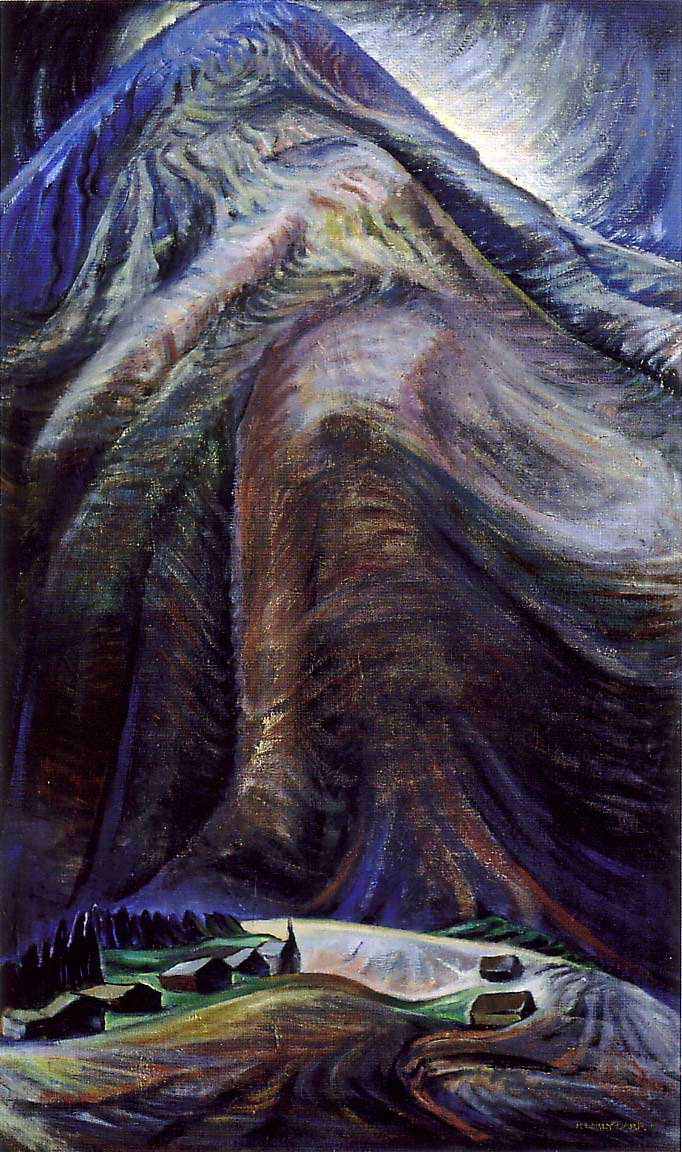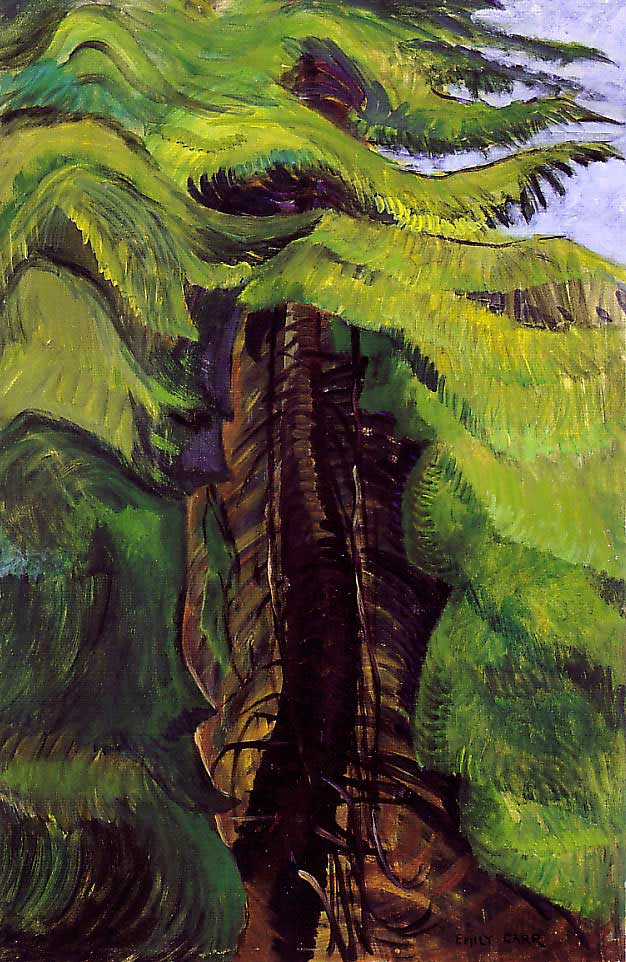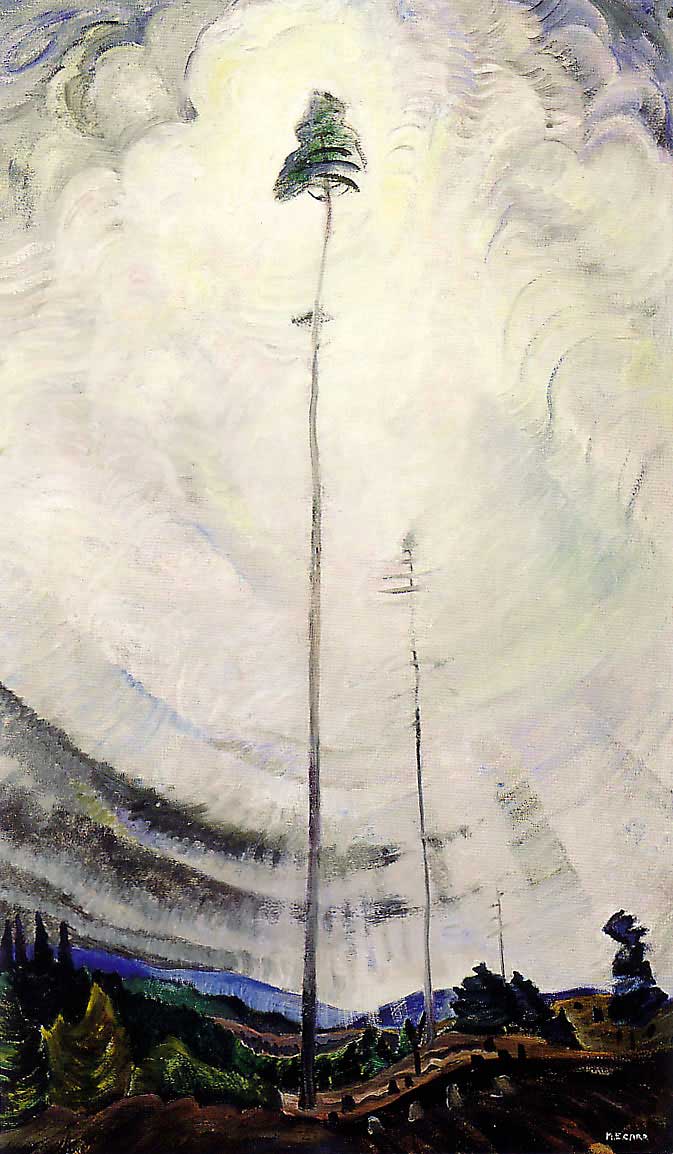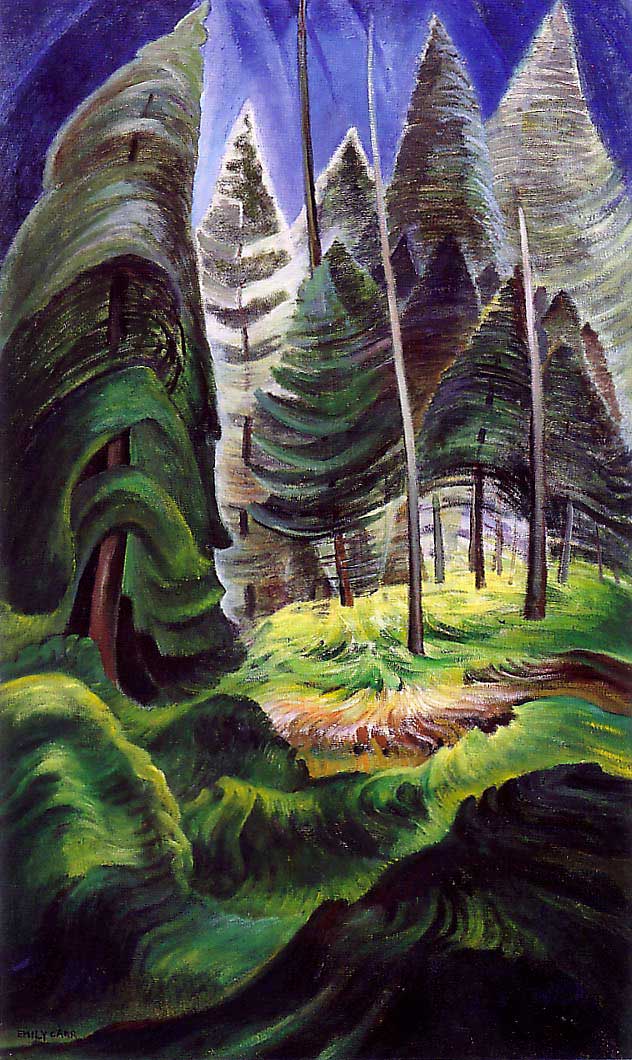Dear Artist,
In a recent interview, the noted art dealer, collector and benefactor Eugene V. Thaw, was asked how he would define the art of collecting art. “It’s all about ordering,” he said. “It’s about making some sense out of a group of related objects and having each one reinforce the others. As a collector you should always be reaching for better examples of what you have, and you need to find out what you’re missing. You fill in the blank spaces.”
Apart from giving an insight into a collector’s mind, Thaw’s statement also gives a clue to the machinations of artists’ minds. Creative order takes place in the art process, but it also includes the timely development of ideas and motifs from one work to the next. This ordered assimilation and production is vital to an artist’s progress. Through ebb and flow, ups and downs, and reaching to do better, it’s almost inevitable that blank spaces get filled and valuable idiosyncrasies arise.
The other day I was “deconstructing” Emily Carr paintings in a public gallery. I was trying to figure out the order in which Emily did things — from the first squeeze-out to the final blip. I also wanted to know which paintings she had done before others, and how one idea had led to the next. I was looking to find where she met up with influences like Mark Tobey and Lawren Harris. I wanted to know when she dropped her photographic reference and just painted the spirit she felt. I couldn’t help remembering Eugene Thaw and how he favours art that is worthy of study and can be talked about. You might say his bliss is figuring out the order. Emily offers plenty to figure out.
Many members of our Painter’s Keys community have told me that it’s the processing of their private order that keeps them at it. Achieved systematically in some ways, by happenstance in others, this is the key to developmental creativity. Sneakily, this process also has something to do with developing a collector base — guys like Eugene Thaw. But as living artists, we don’t pay any attention to that, do we? We just work things out in our individual ways. We build in our own order. We are fillers of blank spaces. Sometimes what we do is a great puzzlement to ourselves and others, and maybe that’s the point.
Best regards,
Robert
PS: “Perfectly ordered disorder designed with a helter-skelter magnificence.” (Emily Carr, 1871-1945)
Esoterica: Emily Carr produced her strongest work after her middle fifties. The ordered confluence of reality, imagination and spirit made it happen for her. Painted in what she called “the marvelous modern manner,” her work would have been insignificant had she relied only on previous directions of reality, imagination or spirit. Emily spent half a lifetime tying together the loose ends of chaos and the confusion of nature. Only then was she able to put order to her vision. “Chaos is the law of nature; order is the dream of man.” (Henry Brooks Adams)
Emily Carr Paintings
The Mountain: The power of scale. Inward sweep and eye control at the bottom, formless threat above. Lawren Harris would have approved.
Cedar Sanctuary: Undulation and dance. Centralized motif is an ordered, monumental paean to the forest. Escape from Victorian strictures.
Scorned as Timber, Beloved of the Sky: The cry of isolation. The wispy wipeouts of the fragile, tentative stems. The halo. Mark Tobey would have approved.
A Rushing Sea of Undergrowth: Ordered and interactive design. Full-blown contiguous abstraction. The forest floor as ocean. ‘The marvelous modern manner.’
Lazy body attack
by Jeanne Long, Minneapolis, MN, USA
The lazy physical body doesn’t want to plan. It wants to pick up any size paper, toss on pigments and have the world beat a path to its door. It feels cheated when it has to plan. Gypped. It thinks, “Other painters don’t have to do this. They just go to their perfect studios and their work just flows out of them unplanned. The muses do the work!” So every once in awhile this laziness gets to have its way, goes to the paints and has a go at it, on its terms. It always fails. Crop it a zillion ways. There’s nothing there worth looking at. The next day, a plan is made, pigments are put on in proper order and a decent painting often results. And the lazy body just goes underground, planning its next attack. And it will again have its way.
Order of the universe
by Tony Saladino, Hurst, TX, USA
We artists have not only the opportunity but the challenge to “order” our canvases in such a way that they can both capture the viewer’s attention and get that viewer coming back to see more. The order in our work is a derivative of the order of the universe. Just as Fibonacci Numbers show the elegance of order in the universe, our canvases can be structured in a way that compels the viewer be interested. We divide the parts of the canvas such that they look good. Within that order we play with compositional elements that allow us to use our “marks” and gestural idiosyncrasies to do a piece that can be like no other. As we always consider the visual order, we have the opportunity to “tweak” pictorial space so that colors vibrate and lines dance and the viewer is enticed to look and keep looking to see what we have to say.
Emily Carr’s life connects
by William Lathrop, Evansville, WI, USA
I have been spending some reading time with Deepak Chopra. He is telling me to pay attention to the coincidences in life — they are there to tell us something, he says.
What am I to make of the fact that I am now listening to a novel titled, The Forest Lover by Susan Vreeland? I am listening to this book on tape while I paint — and it imagines the life and wanderings of Emily Carr. And today’s twice weekly letter — which I am always deeply appreciative of — mentions Carr and her work. During the particularly repulsive stretch of winter we’ve been having in Wisconsin during the last month, this novel has helped connect me to the greener world that is the cornerstone of my own work. I highly recommend the book.
Carr’s supports
by Virginia Wieringa, Grand Rapids, MI, USA
Those big later paintings of Emily Carr shown above were done in a very non-archival way. Some of them are on newsprint with kerosene as the solvent for her oils! They are explosive in more ways than one!
(RG note) Thanks, Virginia. Emily’s supports varied from stretched linen canvas to brown (butcher) paper, and other commonplace items. Some of her most popular paintings are quite fragile. Many were merely sketches, but there is also the suspicion that she thought herself not worthy of proper materials.
Clipping off
by Adam Cope, Lanquais, Dordogne, France
Discipline (la taille) for a gardener is an afterthought that should only ever be tenderly applied to a vigorous stock which has been nurtured and fed and allowed to grow in its own direction. A plant needs to find its natural form, the one that suits its growth pattern before it can be clipped. (Emily Carr’s vision was the flowering of such a nurturing process, in which she had reached a stage where she could clip away the unnecessary — the elements which hinder growth. A painter needs the full realization and the full visibility of an image. Clipping off too many ‘loose ends’ too early risks cutting off vital light and water, the leaves and roots of the creative process. Another painter once remarked to me that he only ever felt he was painting ‘for real’ when he had most of the surface covered. Interesting to read your ‘tying together loose ends,’ rather than clipping off.
Overwhelmed with process
by Darlene Gray, Regina, SK, Canada
In my learning to paint, I struggle with what to do first and next. I go back and forth, changing my mind to the point where my desire to create, to paint, is frustrated. Wishing to start over inevitably sets in and just as I get committed to that thought, I try one last time to change what I have and it usually works. In the rest of my life I am usually and easily organized, goal orientated. But with painting, it seems there is so much that needs to be done first. Perhaps it is like learning to drive a car. Once you learn and practice, your foot chooses the brake or gas pedal before your consciousness has had time to consider all the factors. Hopefully, once I establish a routine for myself I will not be so overwhelmed with process. As Emily Carr did, I believe I can then bring more abstract elements into my work. Thank you for that awareness.
Core element unifies
by Martine Gourbault, Vancouver, BC, Canada
I love that one idea carries inside it the germ of another. How would we ever manage without this miraculous occurrence? The challenge for me, being something of an art gypsy, is to not take too big a leap from one idea to next or, before I know it, I will have embarked on a whole new series which will bear little resemblance to where I began. The gap becomes too wide to fill and I find I have little interest in backtracking to fill it. Even now when I am determined to be more consistent and stay focused, I am constantly aware of how easy it is (and usually temptingly interesting!) for me to wander off in a new direction, and this can be caused by a very subtle shift. The solution appears to be to identify just what the core element is that ties one painting to another, and that which, no matter what else ends up surrounding it, will eventually come to unify the whole. Would you agree? Sounds easy enough.
Individual reality affects vision
by Gaye Adams, Sorrento, BC, Canada
My observation as an art instructor is that the process of breaking down and ordering visual information in order to find a “way” to paint something varies from individual to individual as much as fingerprints do. I used to think if I presented my way of making sense of a subject matter in terms of translating it into a viable painting, it would be a straightforward matter for a student to grasp it and utilize it. What makes sense to me, should make sense to someone else.
There was also a time in my life where I was naive enough to think that others thought and felt just as I did that my reality was everyone else’s reality, or at least close to it. I am a little older and wiser these days, and it makes me a better painter and a better instructor to have learned, both in life and in art, what a fascinating thing it is to try to understand the other fellow’s take on things. As always, my students are also my teachers.
Creating on a whim
by Lynn Harrison, Toronto, ON, Canada
When I’m creating, I often feel I’m doing so on a whim or because some coincidental event has pointed me in a particular direction. Later, when I look at a group of works together (in my case, they’re songs in a set list) I realize I was unconsciously ordering my world by choosing to frame one particular event or subject and not another. It takes a bit of time or distance to get a sense of the larger whole, and it’s illuminating to see where the blank spaces are (what am I not looking at?) and which pieces seem to “not fit” (or do they, in a way I don’t yet see?).
No such thing as perfect
by Jace Mattson, Denver, CO, USA
I find that now when I approach a painting I don’t hesitate and think of all the “right” ways to express the concept. I think that when we are young we think we have all the time in the world to make it perfect. In fact, we think there is such a thing as perfect. It’s different now. There is a fuel factor. I don’t want to run out of gas before getting there! Taking the best or at least the most memorable of what I learned in my twenties and unconsciously applying it to what my mission is at 55 has helped me to paint faster, dream bigger and not worry about what “perfect” looks like. I am like a guitar player who has been playing for 20 years. I’m not thinking about my fingers anymore!
Mind’s eye seeing
by Judy (Fuller) Roberto, San Jose, CA, USA
As physical vision diminishes, what remains unaffected is the “mind’s eye.” If this vision has been cultivated, not only will it assist physical vision in even the most mundane tasks, it can become director of creativity. As in autumn leaves, brilliant reds, oranges and yellows are only visible because the green has faded; so too the mind’s eye now can inform our art, unfettered by such strict, realistic input.
Suggestions needed
by Marie Martin, Fountain Valley, CA, USA
I have been trying to locate a book on painting seascapes. My medium is acrylics. I find a few for oils and watercolor, but not a lot, nor any that look particularly good. Of course, there are many for watercolor. Oils would be my second choice if none are available regarding acrylics. I’m particularly interested in learning the dynamics of wave movements. I can stare at the ocean forever, but just don’t think I’m going to get the proper energy behind my brush strokes until I understand the physical dynamics of how they move forward, crest, peak, crash, recede. Also need some ideas for mixing those really pale, luminescent greens that appear at the top of waves. I’ve had some success, but I can’t seem to express the delicacy of the luminosity. Any suggestions would be helpful.
(RG note) Thanks, Marie. Nothing beats the smell of the sea and the roar of the waves. Water in action has its own dynamics and demands the student to go into observation mode. Learn to Paint Coastal Landscapes by Ray Balkwill is a valuable book by a well known professional. Essentially for watercolourists, Paint the Sea and Shoreline in Watercolors Using Special Effects by E. John Robinson is nevertheless useful in all media for its wide range of effects and crossover techniques.
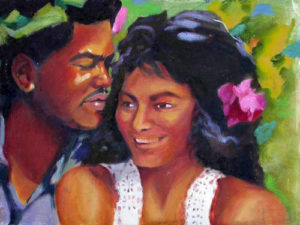
Zion and Kathleen oil painting |
You may be interested to know that artists from every state in the USA, every province in Canada, and at least 115 countries worldwide have visited these pages since January 1, 2013.
That includes Kathy Krouse of Felton, DE, USA who wrote, “I found Emily Carr’s paintings to be very weird and ‘rushing’ and would not have bought any one of them. Did she sell a lot of her paintings, and were they all like the ones you posted?”
And also Darney Willis who wrote, “I like to say we create ‘precarious order’ and ‘dynamic expressive communication’ is one of the strongly significant in creating art.”
And also Clotilde Sofikitis of Austin, TX, USA who wrote, “I wish in my life I just did not have to do domestic things for my boyfriend. I will now hopefully take more charge of my past to bring forth new paintings. I have been charitable with my art for decades but now I find myself thinking otherwise.”
And also Sandy Geller of Chevy Chase, MD, USA who wrote, “I like the idea of blank spaces and that they get filled. I also like blank spaces that are allowed to be. Some kind of creative tension arises from the nothingness.”
And also Barbara Woollcombe of Pender Island, BC, Canada who wrote, “I had an ‘aha’ moment when I looked at the Emily Carr paintings in the clickback. The ones you chose to comment on are all done in ‘portrait’ style — vertical. Reaching for the sky, perhaps. Maybe that’s the secret — keep reaching.”
And also Ursula Kirchner of Stuttgart, Germany who wrote, “Goethe said, Sammler sind glückliche Menschen. (Collectors are happy people.) It’s as easy as that. It’s fun to go about and find things.”

